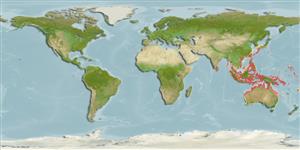>
Ovalentaria/misc (Various families in series Ovalentaria) >
Pseudochromidae (Dottybacks) > Pseudochrominae
Etymology: Labracinus: Greek, labrax, -akos = a fish, Dicentrarchus labrax (Ref. 45335); cyclophthalmus: Name from Greek 'kyklos' meaning circle and 'ophthalmos' for eye, referring to the dark curved marking around the midposterior rim of the orbit..
More on authors: Müller & Troschel.
Environment: milieu / climate zone / depth range / distribution range
Ecologia
marino associati a barriera corallina; distribuzione batimetrica 2 - 20 m (Ref. 9710), usually 10 - 15 m (Ref. 27115). Tropical; 22°C - 26°C (Ref. 27115)
Western Pacific: widely distributed throughout the Indo-Malayan Archipelago, from southern Japan, south to the Northwest Shelf of Australia, and east to New Ireland, Papua New Guinea.
Size / Peso / Age
Maturity: Lm ? range ? - ? cm
Max length : 23.5 cm TL maschio/sesso non determinato; (Ref. 90102)
Spine dorsali (totale): 2; Raggi dorsali molli (totale): 24-26; Spine anali 3; Raggi anali molli: 14 - 15. Lower lip uninterrupted at symphysis. Vomerine teeth relatively large, arranged in a chevron. Caudal fin rounded; upper part with 5 - 6 procurrent rays and 9 principal rays. Lateral line with anterodorsal series of 43 - 62 (usually 48 - 62) tubed scales extending from gill opening, and a peduncular series of 12 - 14 (usually 18 - 22) tubed scales. Dorsal and anal fins with distinct scaly sheaths (Ref. 37748).
Found near shelter of coral or rock of shallow reefs (Ref. 9710), with moderate surge or currents, in spread-out groups of mixed sexes. Also in tidal pools, reef flats and reef slopes, often in relatively silty areas at depths ranging to 20 m (Ref. 81967). Moves about activity through the gutters and passages (Ref. 48635). Feeds on small fishes (Ref. 559). Frequently seen in the aquarium fish trade, and has been bred in captivity (Ref. 35416, 37748).
Life cycle and mating behavior
Maturità | Riproduzione | Deposizione | Uova | Fecundity | Larve
Kailola, P.J., 1987. The fishes of Papua New Guinea: a revised and annotated checklist. Vol. II Scorpaenidae to Callionymidae. Research Bulletin No. 41, Research Section, Dept. of Fisheries and Marine Resources, Papua New Guinea. (Ref. 6192)
IUCN Red List Status (Ref. 130435)
Threat to humans
Harmless
Human uses
Acquario: Commerciale
Informazioni ulteriori
Nomi ComuniSinonimiMetabolismoPredatoriEcotossicologiaRiproduzioneMaturitàDeposizioneSpawning aggregationFecundityUovaEgg development
BibliografiaAcquacolturaProfilo di acquacolturaVarietàGeneticaElectrophoresesEreditarietàMalattieElaborazioneNutrientsMass conversion
Strumenti
Special reports
Download XML
Fonti Internet
Estimates based on models
Preferred temperature (Ref.
123201): 26 - 29.3, mean 28.7 °C (based on 1882 cells).
Phylogenetic diversity index (Ref.
82804): PD
50 = 0.6250 [Uniqueness, from 0.5 = low to 2.0 = high].
Bayesian length-weight: a=0.01995 (0.00906 - 0.04395), b=3.01 (2.83 - 3.19), in cm total length, based on all LWR estimates for this body shape (Ref.
93245).
Trophic level (Ref.
69278): 3.9 ±0.4 se; based on diet studies.
Resilienza (Ref.
120179): Medio, tempo minimo di raddoppiamento della popolazione 1.4 - 4.4 anni (Preliminary K or Fecundity.).
Fishing Vulnerability (Ref.
59153): Low vulnerability (14 of 100).
Nutrients (Ref.
124155): Calcium = 65.3 [32.3, 100.0] mg/100g; Iron = 0.654 [0.379, 1.062] mg/100g; Protein = 18.6 [17.5, 19.8] %; Omega3 = 0.109 [0.065, 0.178] g/100g; Selenium = 23.1 [12.3, 45.1] μg/100g; VitaminA = 126 [38, 396] μg/100g; Zinc = 1.04 [0.69, 1.51] mg/100g (wet weight);
